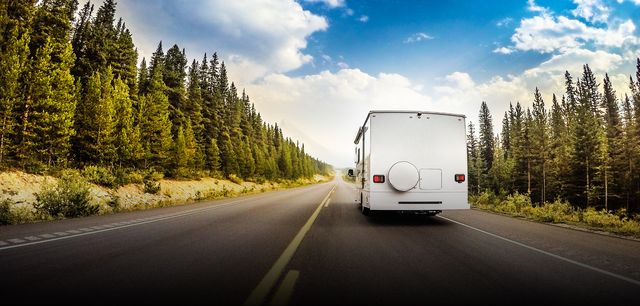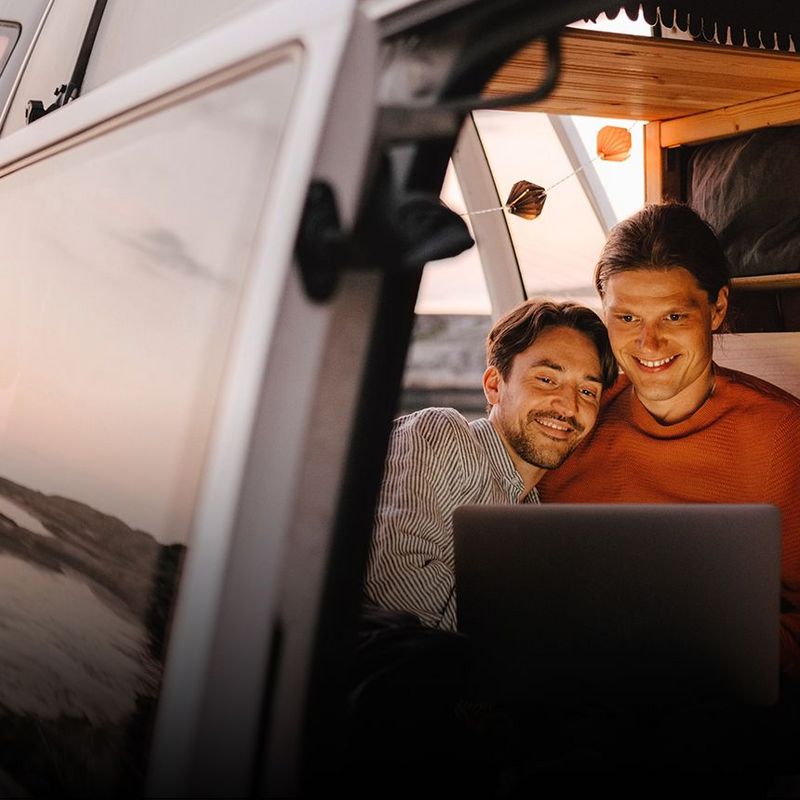09. June 2022
They’re too heavy, too expensive and don’t give you the range you need: electric motorhomes are still few and far between, which is why it’s currently difficult to avoid diesel. Our checklist reveals how to save fuel on your travels to protect the environment – and your own wallet.
What you buy will be key to what you spend
Whether new or used, there’s a huge range of motorhomes to choose from. As things stand, however, high prices are being charged even for very old motorhomes. Which is why it can pay off to buy a new motorhome with state-of-the-art engine technology.
Before buying a motorhome, you should look into its emissions class and consumption values. The rule of thumb is this: the different types of motorhomes on the market also differ in respect of their fuel consumption. A liner the size of a bus will of course consume significantly more fuel than an alcove mobile home. But because of its height, the latter will in turn use more fuel than a panel van, whose consumption may well be higher than that of a versatile campervan.
Drive with foresight
Anyone who drives with foresight will use less fuel – this applies to cars just as much as it does to motorhomes. You should therefore start to slow down early when the lights change to red, when approaching a junction or before turning into a side road.
On the motorway,your consumption will increase exponentially with your speed. If you always drive at top speed or are in the habit of overtaking lorries, you will feel this when you get your wallet out at the petrol station, if not before.
Using cruise control and driving in the slip stream of a lorry will take all the stress out of your journey. The general recommendation is to drive carefully and shift up to the next gear as soon as you can. In newer motorhomes, the shift display offers useful guidance here. This shows which gear you are currently in and when you should change up or down. Modern motorhomes also come with an automatic start-stop system, which helps to save money, especially during long waiting times, for example at level crossings, traffic lights, bascule bridges or in traffic jams.
Using the air conditioning system will add to your fuel consumption – making a not inconsiderable difference. If you don’t absolutely need it, you should switch it off. This will save you a fair amount of fuel.
Check your vehicle before you leave and spare yourself grief later
If you don’t want any defect-related nasty surprises on your journey, you shouldn’t head out unless your motorhome is in a technically perfect condition. For this reason, you are strongly recommended to check your vehicle before you start your trip. If you can’t or don’t want to do this yourself, it’s worth booking it into a garage for a “holiday check”.
A defective control unit or broken lambda sensor can lead to high fuel consumption. The same applies to a dirty air filter. Using low-friction oils can also save a certain amount of fuel.
In general, maintenance in the specified period or at a certain stated mileage is advisable. In this way, you will always take to the road in a serviced motorhome and avoid the risk of voiding your warranty.
© AdobeStockAvoid unpleasant surprises on holiday by carrying out a technical check before the start of the journey. Then, hopefully, it's all clear!
The right tyres will help your fuel economy
The choice of tyre alsohas an influence on fuel consumption. Basically, you shouldn’t drive on winter tyres for any longer than you have to, and you should increase your tyre pressure by 0.2 bar. When buying new tyres, low-friction tyres with lower rolling resistance are a good choice.
Shed any excess weight
Every kilogramme of extra equipment will have a negative effect on payload, handling and driving performance – and, of course, on fuel consumption. In other words, there are lots of good reasons to pay attention to weight.
Drinking water reserves and wastewater will quickly mount up and add unnecessary ballast. After all, a drinking water tank holds around 100 litres, in large liners up to as much as 500 litres. This is why you should only ever refill your tank when you get to your destination! And always empty your wastewater tank before continuing your journey.
If possible, dispense with your roof box. This will drive up the cw value, i.e. the motorhome’s air resistance. This also applies to open windows or roof hatches, which increase the cw value, especially when you’re driving fast.
A sensible piece of additional equipment will in all cases be a solar power system. This will make the vehicle self-sufficient and take the strain off the alternator, and you will not have to connect the motorhome to the mains when you park up at the campsite. This will save on electricity and energy elsewhere.
© AdobeStockThe water tank should be checked for functionality before setting off - and only filled with the maximum permissible amount of water at the destination.
The best things are close at hand
Here’s a reliable fact: the further you drive, the more fuel your motorhome will burn. Your choice of destination can therefore also save a lot of fuel. Is that trip to the North Cape really necessary? Or would you rather spend your well-deserved holiday in your own country? One thing is certain: in many European countries, there are lots of attractive holiday regions with good infrastructure for motorhome enthusiasts.
In general, the duration of the trip should be reasonably proportional to the distance you travel. When driving to and in the destination region, your satnav will help: it will generally take you to your destination via the most direct route. This will both save fuel and promote ease of mind – after all, you are on holiday!
© iStockSo close, so beautiful: if you opt for Austria instead of Sicily, you'll have fewer kilometres on the clock - a significant cost factor.
Your fuel-saving tips at a glance:
- Think carefully about your choice of vehicle
- Adapt your driving style
- Use aids: cruise control, automatic start-stop etc.
- Make sure your motorhome is in technically perfect condition
- Choose the right tyres
- Save weight
- Do without a roof box
- Choose your destination accordingly






